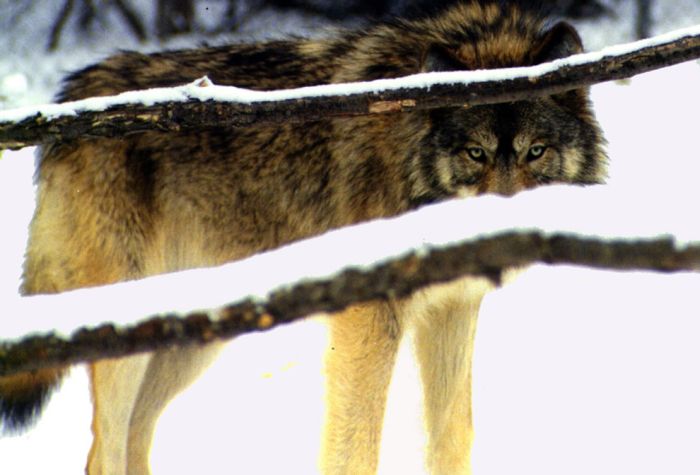Gray Wolf
|
Wolves will kill dogs on occasion, with some wolf populations relying on dogs as an important food source. Wolves generally outmatch dogs, even large ones, in physical confrontations, because of their larger heads and teeth and stronger bites. Also, the fighting styles of wolves and dogs differ significantly; while dogs typically limit themselves to attacking the head, neck and shoulder, wolves will make greater use of body blocks, and attack the extremities of their opponents. In Croatia, wolves kill more dogs than sheep, and wolves in Russia appear to limit stray dog populations. Wolves may display unusually bold behaviour when attacking dogs accompanied by people, sometimes ignoring nearby humans. Wolf attacks on dogs may occur both in house yards and in forests. On village outskirts, wolves may set up ambushes for dogs, with one wolf soliciting the dog to follow it and lead it to another wolf. In some areas, livestock guardian dogs are fitted with wolf collars in order to protect themselves from wolf attacks. Wolves however may learn to avoid the spiked collars just as they do the antlers of ungulate prey, and still kill guard dogs. Wolf attacks on hunting dogs are considered a major problem in Scandinavia and Wisconsin. The most frequently killed hunting breeds in Scandinavia are harriers, with older animals being most at risk, likely because they are less timid than younger animals, and react differently to the presence of wolves. Wolf-caused injuries on dogs are often located on the back, thighs and hind legs. The fatal wound is mostly a bite to the back of the neck. Large hunting dogs such as Swedish elkhounds are more likely to survive wolf attacks due to their better ability to defend themselves.
• Attacks on humans
Wolves are generally not dangerous to humans, as long as they are in low numbers, have sufficient food, have little contact with humans and are occasionally hunted. The number of people attacked and killed by wolves varies geographically. Wolf attacks on humans were a rare, but occasional feature of life in pre-20th century Europe: in France alone, historical records indicate that during the period 1580–1830, 3,069 people were killed by wolves, of whom 1,857 were killed by non-rabid wolves. Church and administrative accounts from Italy indicate that 440 humans were killed by wolves during the 15th and 19th centuries, occurring in the central part of the Po Valley, which once encompassed part of modern day Switzerland. Prior to 1882, 94 children under the age of 12 were killed in Fennoscandia by non-rabid wolves in a 300 year period. European Russia also records numerous attacks, particularly in pre-revolutionary times and after World War II. Between 1840 and 1861, 273 non-rabid attacks resulting in the deaths of 169 children and 7 adults occurred throughout Russia, while between 1944 and 1950, 22 children between the ages of 3 and 17 were killed by wolves in the Kirov Oblast. There are numerous documented accounts of wolf attacks in the Asian continent, with three Indian states reporting a large number of non-rabid attacks in recent decades. These attacks were well documented by trained biologists. In Hazaribagh, Bihar for example, 100 children were injured and 122 killed from 1980 to 1986. The North American continent has very few recorded incidences of such, though the oral history of some Native American tribes confirms that wolves occasionally did kill humans. Tribes living in woodlands feared wolves more than their tundra-dwelling counterparts, as they could encounter wolves suddenly and at close quarters. It is thought that the reason why so fewer attacks are recorded in North America than in Eurasia is linked to the former's historically greater availability of firearms, whose usage taught North American wolves to fear humans more than their Eurasian counterparts. However, encounters with aggressive wolves in North America seem to be on the increase. One study revealed 80 events in Alaska and Canada where wolves closely approached or attacked people, finding 39 cases of aggression by apparently healthy wolves, and 29 cases of fearless behavior by nonaggressive wolves.
Recorded incidences of rabid wolves in Eurasia go far back as the 13th century. The number of cases of rabid wolves are however low when compared to other species. Wolves do not serve as primary reservoirs of the disease, but can catch it from other animals such as dogs, jackals and foxes. Cases of rabies in wolves are very rare in North America, though numerous in the eastern Mediterranean, Middle East and Central Asia. Wolves apparently develop the "furious" phase of rabies to a very high degree. This, coupled with their size and strength, make rabid wolves perhaps the most dangerous of rabid animals, with bites from rabid wolves being 15 times more dangerous than those of rabid dogs. Rabid wolves usually act alone, travelling large distances and often biting large numbers of people and domestic animals. Most rabid wolf attacks occur in the spring and autumn periods. Unlike with predatory attacks, the victims of rabid wolves are not eaten, and the attack generally only lasts a day. Also, the victims are chosen at random, though the majority of cases involve adult men.
|
|









